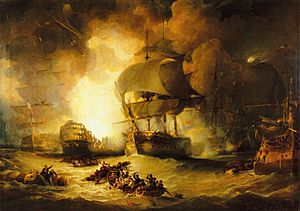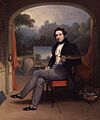George Arnald facts for kids
George Arnald (born in 1763 – died November 21, 1841) was a British artist known for painting beautiful landscapes. He also created detailed pictures for books about different places. His most famous painting shows a dramatic moment from the Battle of the Nile.
About George Arnald

George Arnald was born in 1763. We don't know much about his early life. Some say he was born in a village called Farndip (now Farndish) in Northamptonshire. Others believe he was born in Berkshire.
It's thought that Arnald first worked as a house helper. Later, he decided to study art. He learned from a landscape painter and engraver named William Pether.
Arnald first showed his artwork at the Royal Academy in 1788. Over his career, he displayed 176 paintings there. He also showed 63 works at the British Institution. He became an associate member of the Royal Academy in 1810. However, he never became a full member.
His most famous painting is quite different from his usual landscapes. It's called The Destruction of L'Orient at the Battle of the Nile, August 1, 1798. This is the only known painting by Arnald that shows a sea battle. It was one of four paintings chosen for a competition. The winning artworks were meant to hang in the Painted Hall of Greenwich Hospital.
Arnald's painting was shown in 1827. Today, you can see it at the National Maritime Museum in Greenwich, London.
George Arnald was friends with another painter, John Varley. In 1798 and 1799, they traveled through Wales together. Arnald also taught art to students. One of his students was Henry William Pickersgill, who became a very successful portrait painter. Pickersgill painted famous people like William Wordsworth and the Duke of Wellington.
Besides creating illustrations for books, Arnald also published his own works. In 1828, he released a collection of drawings of the River Meuse. In 1839, he wrote a book called A practical treatise on landscape painting in oil. This book taught others how to paint landscapes using oil paints.
George Arnald passed away in Pentonville, London, on November 21, 1841.
Where to See Arnald's Art
You can find George Arnald's paintings in several important art collections. These include:
- The Tate Collection
- The Royal Academy of Arts Collection
- The National Portrait Gallery in London
- The collections of the University of Liège in Belgium
His painting Charles I before Hull is at the Ferens Art Gallery in Kingston upon Hull. His scene The Army under Cromwell marching to Winchester is in the Winchester City Museum.
Books Illustrated by Arnald
George Arnald's artwork was used to illustrate several books, such as:
- Scott, W. The Border Antiquities of England and Scotland. Edinburgh: 1814
- Dugdale, James. The New British Traveller. London: J Robins & Co, 1819
- Wright, Thomas. History and Topography of the County of Essex. London: G. Virtue, 1836
Images for kids


